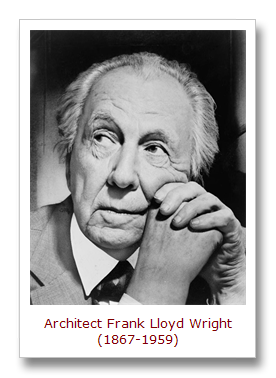Many books of quotations include a famous humorous quote by the eminent American architect Frank Lloyd Wright:
“The physician can bury his mistakes, but the
architect can only advise his client to plant vines.”
This quote is usually given without any context, except to say that it comes from an article in the October 4, 1953 issue of The New York Times Magazine. (It’s sometimes simply cited as being from The New York Times, but was technically in the paper’s “magazine” section.)
I had once assumed that the quote was from an interview. However, when I looked it up in the online New York Times archive, I discovered that the article was written by Wright himself and that origin of the famous quote actually dates back to 1931.
When the NYT article was published in 1953, Wright was 86 years old. He was renowned as one of the greatest architects in the world. And, he was working on two of his final major projects: the Price Tower in Bartlesville, Oklahoma (his only skyscraper) and his amazing, spiral-shaped masterpiece, the Guggenheim Museum in New York City.
Wright’s NYT article was essentially his own overview of his career, starting in 1893 when he left the firm of his mentor Louis Henry Sullivan and began designing his famed “Prairie Houses.”
He opened the article with this anecdote:
Of course, I will never forget the sensations when the Winslow House was built in 1893 in Oak Park [Illinois], the year I left Adler & Sullivan and started my own practice. All Oak Park and River Forest began prowling around the place: I remember climbing up into an upper part of the building during construction to listen to comments. I pulled the ladder up and waited. In came a young fellow with a couple of young women and the fellow said, “Have you seen the man who built this? God, he looks as if he had a pain.” Another one said, “They say this cost $30,000, but I can’t see it.” So I learned my lesson: I never listened like that again.
Wright went on to mention many of his most famous buildings and innovations in the article, including his new projects, the Price Tower and the Guggenheim.
He ended the article by noting some advice he’d given to young architects in a 1931 lecture in Chicago.
In the NYT piece, Wright briefly summarized that advice and gave the following version of his view on the difference between doctors and architects:
“The physician can bury his mistakes, but the architect can only advise his client to plant vines — so they should go as far as possible from home to build their first buildings.”
The first part of that quote is what shows up in most books of quotations.
The second part that advises architects to build their first buildings far from home may reflect Wright’s unpleasant eavesdropping experience at the Winslow House back in 1893.
In Wright’s 1931 lecture (published later that year in his book Two Lectures on Architecture), the two parts of the famed “plant vines” quotation are reversed. They appear as the 11th of 14 key recommendations Wright gave to young architects. Here are all 14…
1. Forget the Architectures of the world except as something good in their way and time.
2. Do none of you go into Architecture to get a living unless you love architecture as a principle at work, for its own sake — prepared to be as true to it as to your mother, your comrade, or yourself.
3. Beware of the Architectural school except as the exponent of engineering.
4. Go into the field where you can see the machines and methods at work that make the modern buildings, or stay in construction direct and simple until you can work naturally into building-design from the nature of construction.
5. Immediately begin to form the habit of thinking “why” concerning any effects that please or displease you.
6. Take nothing for granted as beautiful or ugly, but take every building to pieces, and challenge every feature. Learn to distinguish the curious from the beautiful.
7. Get the habit of analysis—analysis will in time enable synthesis to become your habit of mind.
8. “Think in Simples” as my old master used to say—meaning to reduce the whole to its parts in simplest terms, getting back to first principles. Do this in order to proceed from generals to particulars and never confuse or confound them or yourself be confounded by them.
9. Abandon as poison the American idea of the “quick turnover.” To get into practice “half-baked” is to sell out your birthright as an Architect for a mess of pottage, or to die pretending to be an Architect.
10. Take time to prepare. Ten years’ preparation for preliminaries to Architectural practice is little enough for any Architect who would rise “above the belt” in true Architectural appreciation or practice.
11. Then go as far away as possible from home to build your first buildings. The physician can bury his mistakes—but the Architect can only advise his client to plant vines.
12. Regard it as just as desirable to build a chicken-house as to build a cathedral. The size of the project means little in Art, beyond the money-matter. It is the quality of character that really counts. Character may be large in the little or little in the large.
13. Enter no Architectural competition under any circumstances except as a novice. No competition ever gave to the world anything worth having in Architecture. The jury itself is a picked average. The first thing done by the jury is to go through all the designs and throw out the best and the worst ones so as an average, it can average upon an average. The net result of any competition is an average by the average of averages.
14. Beware of the shopper for plans. The man who will not grubstake you in prospecting for ideas in his behalf will prove a faithless client.
I think some of Wright’s advice has application far beyond the realm of architecture. My favorite is the last part of #12: “It is the quality of character that really counts. Character may be large in the little or little in the large.”
Frank Lloyd Wright, who died in 1959 (the year the Guggenheim Museum was completed), clearly brought a huge amount of character to everything he did.
* * * * * * * * * *
Comments? Corrections? Post them on the Famous Quotations Facebook page.
Related reading and viewing…










